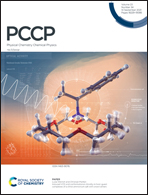A valence balancing rule for the design of bimetallic phosphides targeting high thermoelectric performance†
Abstract
Two-dimensional (2D) materials with outstanding electronic and mechanical properties have attracted considerable attention as efficient thermoelectric materials. Here, we propose a generalized eight-valence electron rule for designing 2D semiconductor materials, i.e., metal-shrouded bimetallic phosphides ABP (A: group IA element, B: group IIA element). Following this rule, we screen out ten stable semiconductors (LiMgP, LiCaP, LiSrP, NaBeP, NaMgP, KMgP, KCaP, RbMgP, RbCaP and RbSrP) with tunable bandgaps in the range of 0.35–2.40 eV by comprehensive first-principles calculations. Among them, the electron mobility of RbMgP can be as high as 2.3 × 104 cm2 V−1 s−1, and the hole mobility of KMgP is estimated to be 9.9 × 103 cm2 V−1 s−1. Moreover, KMgP, KCaP, RbCaP and RbSrP exhibit an ultralow thermal conductivity of 0.02, 0.14, 0.08 and 0.14 W m−1 K−1, respectively. As a result, KMgP and RbCaP monolayers are p-type or n-type thermoelectric materials with a figure of merit of 2.25 and 1.13 at room temperature, respectively. The underlying mechanism of high electron conductivity and low thermal conductivity has been correlated with their unique bonding characteristics, narrow phonon band gap and the scattering from low-frequency phonons. This work demonstrates not only a guiding electron principle to design stable 2D semiconductors, but also a powerful metal-shrouded strategy for discovering high performance thermoelectric materials by decoupling electronic and thermal transport properties.



 Please wait while we load your content...
Please wait while we load your content...